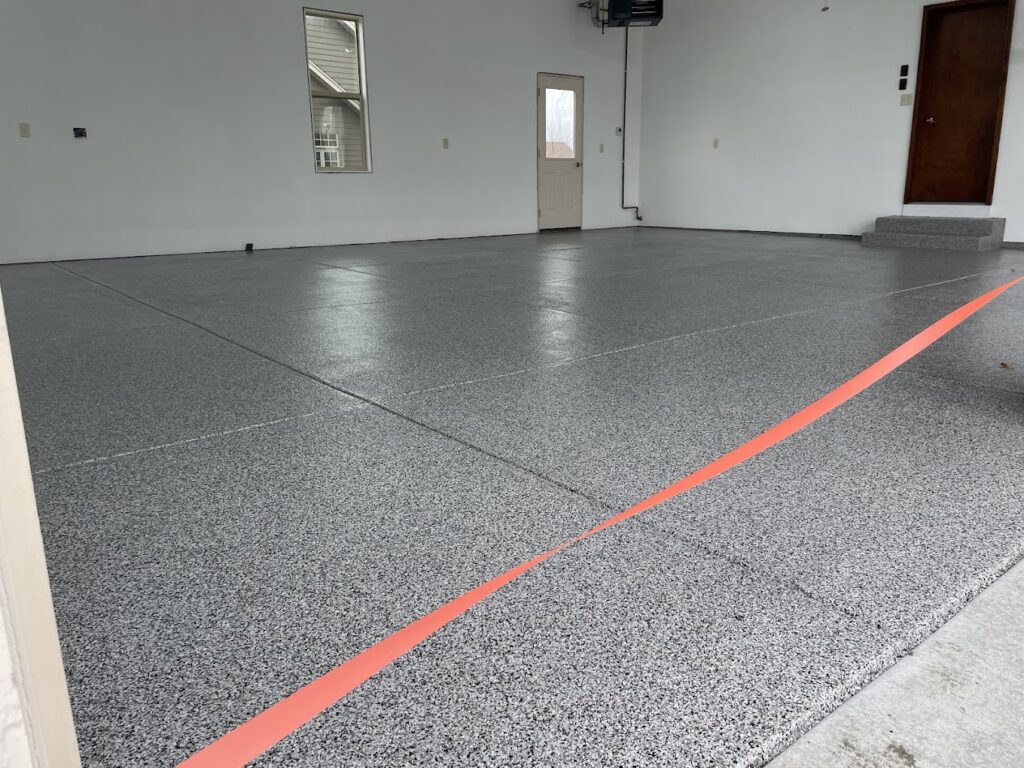In recent years, anything with the phrase “concrete” has gotten a bad rap from environmentalists.
The very idea of anything being “concrete” means that it’s hard to move and lasts a long time, so this can’t be good for the environment… right?
As the highest rated concrete coating company in Waukesha, I want to challenge this belief.
Not only is concrete coatings sustainable – it’s better for the environment (and your pocketbook) in the long term.
Here’s why:
Concrete coatings means increased longevity and sustainability.

Concrete coatings are used to enhance the durability of floors, reducing the need for frequent replacements.
“But doesn’t that mean it lasts forever?”
Nothing lasts forever – but by extending the life of concrete floors, these coatings reduce waste and the demand for raw materials.
For example, a properly applied epoxy or polyurethane coating can protect concrete floors for decades, preventing the environmental impact associated with tearing up and disposing of old flooring.
Sustainable building practices emphasize the reuse of existing materials.
Concrete coatings amplify this by allowing old or damaged concrete floors to be refurbished rather than replaced. This means that a floor that otherwise would have to be demolished, can be saved.
And not only that – but with concrete coatings you can even choose the design of flake colors you want to have instead of starting completely from scratch.
Imagine a historic building where the original concrete floors were preserved and restored using clear polyurethane coatings.
This approach not only maintained the building’s historical integrity but also prevented the environmental impact of removing and disposing of the old flooring.
The opposite would be hiring polluting construction equipment to replace the floor with another material, which would have to be replaced more often anyways.
Does that sound sustainable to you?
Low VOC formulations continue to be more popular.

VOC stands for “Volatile Organic Compounds.”
These are organic chemicals that have a high vapor pressure at room temperature, which leads to a large number of molecules evaporating or sublimating from the solid or liquid form of the compound and entering the air.
In recent years, manufacturers have made significant strides in reducing the volatile organic compounds (VOCs) in concrete coatings.
VOCs are notorious for causing air pollution and potential health issues.
Luckily, states like ours in Wisconsin passed laws preventing the use of dangerous chemicals to the degree where they could harm residents or the contractors coating the floors.
Because air travels up – basement concrete coatings have never been safer to do than today.
For example, today’s eco-friendly coatings include water-based epoxies and urethanes, which emit lower levels of VOCs during application and curing, contributing to better indoor air quality and less environmental pollution.
Indoor air quality aside, low VOC coatings contribute to better air quality outside of buildings.
By reducing the release of harmful chemicals into the atmosphere, these coatings help decrease the overall environmental pollution.
A case in point is an office complex in Milwaukee that opted for these eco-friendly coatings to comply with strict environmental regulations and contribute to reducing the urban heat island effect, which is exacerbated by pollutants in the air.
This means we can all breathe safer – inside or outside of buildings.
Energy efficiency improvements means things keep getting better.

You might be asking, “Don’t concrete coatings cost a lot of energy?”
Well, some types of concrete coatings, especially those with reflective properties, can improve energy efficiency in buildings.
By reflecting more sunlight and heat, these coatings help maintain cooler interior temperatures during warm months, reducing the need for air conditioning.
This not only lowers energy consumption but also decreases the carbon footprint associated with energy production.
Energy efficiency is also improved in interior spaces through the insulative properties of our concrete coatings.
By creating a barrier that helps stabilize indoor temperatures, these coatings reduce the need for heating and cooling, which are among the largest energy expenses in buildings.
An office building by Waukesha, for instance, applied thermal insulating coatings to its floors, resulting in a noticeable decrease in energy usage for climate control, thereby promoting a smaller carbon footprint.
You’ll even find that the role of concrete coatings in energy conservation can also be seen in large warehouse facilities for commercial floor coatings.
By applying coatings that help insulate against cold and heat, these facilities avoid the fluctuations in temperature that can lead to increased energy use.
What’s better for the environment – building to last or building to look pretty?
There’s so much talk about using wood floors and other materials that are organic to the environment.
What proponents of this forget, is the cost to ship these materials and installments.
Wood can have a short life-span. Especially in our state of Wisconsin, where temperatures can get crazy cold in the wintertime.
And if a problem with the installation happens, the wood get’s insects, or anything else break – the cost and environmental damage of fixing that is huge.
Compare that to concrete.
It’s simple, durable, and more than ever environmentally friendly.
What matters is what’s built to last, and concrete floors do just that.
